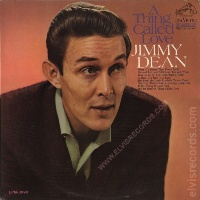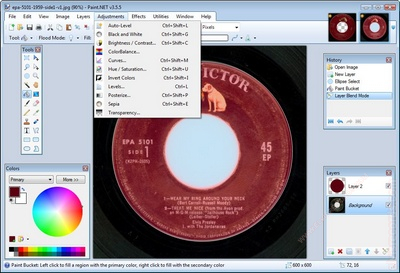I scan each side of the album four times, which produces file sizes over 1MB each with the dimension of the 2550x3500 range. This is an example of each of the scans, significantly reduced in size to demonstrate how the album is scanned.




Use the Windows Live Photo Gallery to "stitch" together each of the scans to create a larger, more complete composition. There is even a tutorial on how to create panoramic views.
The resulting panoramic image is approx. 4265x4100 by dimension and 4.93 MB in size. This image is reduced in size to demonstrate the result.

Use Paint.NET, a free image and photo editing software for computers that run Windows, to rotate the image, crop the edges to a squared dimension, then reduce the size of the image to the dimension of 600x600. Name the image something meaningful like, 3999-lpm-cover-side1.jpg. This image is reduced in size to demonstrate the result.

The following records have been removed from this site checklists, individual pages, and want lists as these were included either in error as they could not exist or have never been identified, nor documented by any major collector. Some of these titles do exist in various publications, however have never been confirmed to exist.
- LSP-3921 Elvis' Gold Records Volume 4, black label, dog near top
- LSP-4530 Love Letters From Elvis, black label, dog near top
- LSP-4460 Elvis Country, black label, dog near top
- LSP-3787 Double Trouble, black label, dog near top
- VPSX-6089 Aloha from Hawaii via Satellite, tan label
- CPL1-0606 Elvis: Recorded Live on Stage in Memphis, tan label
- CPM1-0818 Having Fun with Elvis on Stage, black label, dog near top
- APL1-1039 Elvis, Today, black label, dog near top
47-6420 Heartbreak Hotel, Turquoise label, dog on top.
There are a couple of additional variations that exist and are not mentioned on this site. One of these variations is on the 1962 Electronically Reprocessed Stereo album covers. There are at least three places on the album cover where the catalog number is printed. On the front, back, and spline. Although the front and back of the cover is documented, the splines have generally been ignored by this site. There are in some cases (maybe each release although this has not been confirmed here) different combinations of LSP-XXXX (e) and LSP-XXXX between the three locations, only two combinations have been documented here.
The other set of variations that hasn't been documented on this site are the transitional stickers that are likely on each 1976 release. These stickers wrap over the spline at the upper top left corner partially covering the catalog number. The sticker designates the new catalog number for the release. The album itself is likely to be the original catalog number. A sufficient quantity of specimens have not been examined to properly document these stickers.
The smaller images and thumbnails are not branded as not to distract from the overall detail of the image. However watermarks are carefully placed to balance the integrity of the image while protecting the integrity of this site. The decision to implement this strategy was not taken likely. Images originating from this site began to surface in eBay auction descriptions, either referenced as stock photo or no reference at all indicating that the seller has that exact item for sale where which they do not. Images have also been found on other websites without reference to this site. In some cases, the unobtrusive watermark was removed, this forced the position of another watermark in the center of the image. The larger images exist so that a better and more detailed perspective of the item may be appreciated, however, these are branded in an effort to protect the collective work and to advertise this site.
Yes. If you would like to donate an Elvis record, inner sleeve, original reference material like RCA catalogs, Schwanns catalogs, or Billboard magazines from 1956-1977. These items are always appreciated. If the material is used on the website you will be referenced. You will be referenced on our contributors page just for the donation, if not referenced on the website elsewhere.
The purpose of such material is to continue building my library of research material to better document the content on this website.
If you would prefer a PayPal donation. No PayPal donation is too large or too small. All would be appreciated.
This site is operated by the sole expense of an individual. There are hosting fees, ISP charges, domain name service fees, and other nominal costs it takes to maintain a site of this magnitude. There are no advertisements anywhere on this site. However, by no means feel obligated. This site is maintained out of a labor of love and not to be a source of income.
Yes, this site is always accepting new content. Content may be submitted via email. Please put in the subject line a title respective to the content. For example, LPM-1254 or LOC-1035 Elvis' Christmas Album or EPA-747(label variation).
The preferred image quality is a minimum of 300dpi with a minimum size of 600x600. Images should be scanned. Where a camera is used, please reference the images used in this database for quality prior to submitting. The images may be in raw format, where this site will manipulate the images to their final form.
Please note just because the image is submitted does not necessarily mean that it will be used on the site. Images that are incomplete, shot at an angle and not squared, taken with a glare, illegible, or too small will not be utilized. Though the submission is appreciated, a minimum level of quality must be observed or this site wouldn't be a very effective reference.
Each image should be commented in the email, containing any relevant details, such as in variation, matrix numbers, catalog numbers, and more.
Provide how you would like to be referenced. If your information or images are selected for use on the site, a reference will be footnoted.
Where, in the event, an image on the site is updated or replaced as a result of a recent submission, the reference will also be updated to reflect the respective changes. The previous and deleted reference will be added to a "wall" of past contributors on the About page.
Using the best possible resources for image resolution, size, and orientation is sometimes not enough. Some images may have had hand written notations or some other unintended non-manufactured blemish. Some of those images may have been touched up to remove these characteristics. However, at times, the source image may undergo considerable restoration. By doing so, some of the original intended characteristics may be lost. This can best be seen in some of the cleaned images for the DJ Not For Sale singles. Some of the restored images had lost some of the texture and angles of the original image. These images will serve well until better images become available.
An example of too much and maybe unnecessary image restoration may be this example of Loving You. While the image on the left clearly depicts the original orientation and configuration, it is a little dark and in spots a little dirty. However, it depicts a reasonable expectation of what an original back for this release would look like. The image on the right is heavily sanitized. The discoloration was removed, the background whitened, and a little hue added to the pictures for a warmed effect, much like the original. The intent is there, but doesn't truly represent the nuances like texture of the picture on the left.
There may be some images like that of the right, however, for the interest of preserving the integrity of the original image, more like the one on the left will be found
To find a rare record is difficult enough. To find an image of one is almost as difficult to find as the record itself. To find an image worth using can prove to be as difficult as finding the original record itself. In some cases, it is possible to create a mock-up of an extremely rare record while maintaining the original look and feel of the record. To do this, a free program, Paint.NET is used. For this example, a more common, black labeled EP, EP-5101 will become a marooned label EP. Open each of the images. The first image is the rare maroon label EP, the second is the more common black label EP. Both EPs are otherwise identical in font size and placement.
On the black label image, create a layer by pressing the green plus sign on the far right from the Layers window. The result will be another layer, Layer 2. Notice that both layers are checked and the Layer 2 is highlighted.


While Layer 2 is highlighted, select the Ellipse Select (shaped like a dotted circle) from the Tools window. Then take the cursor and draw a circle around the label of the record. Click on the maroon label image at the top.
Select Color Picker from the Tools window. Take the cursor and select the desired color.
A closeup of the Colors window below shows the default black on white change to maroon (the desired color) on white.


Click on the black label image at the top. Note: The image should still be highlighted.
Select Paint Bucket from the Tools menu. Take the cursor and select the area that has been highlighted. The result should be maroon circle.
From the top menu, select Layers -> Layer Properties
A closeup of the Layer Properties window below shows the default Blending Mode as Normal. Scroll from Normal to Lighten. Press OK.


The result is a maroon label EP.
To take it further, select Background from the Layers window.

From the Adjustments menu, select Brightness / Contrast.
Slide the Brightness and Contrast sliders to the desired settings. Press OK.
Save the work. File > Save As. Change Save as Type to JPG (or desired format). Press Save.
The result is spectacular. One of the images below is the original, maroon label. The other is the mock-up of the original.
Answer: The image on the left is the original, and the image on the right is the mock-up.



















